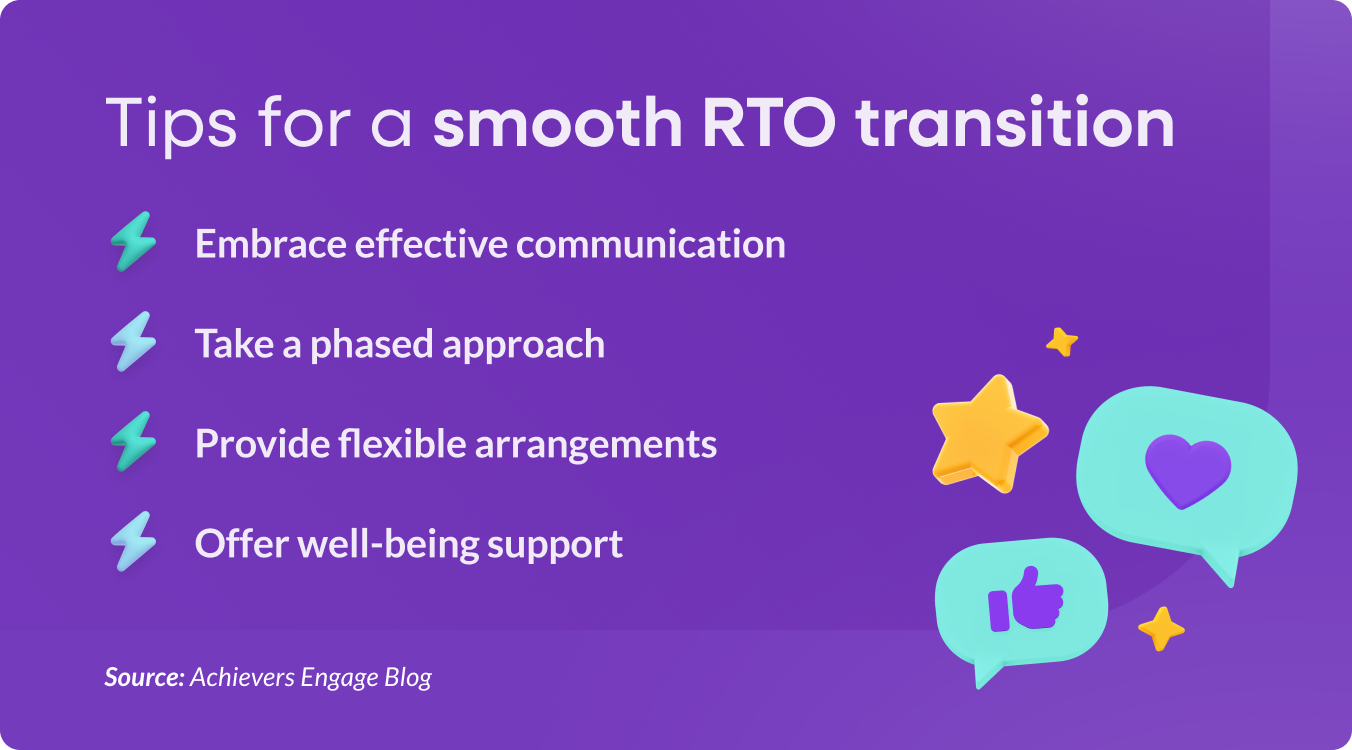Table of contents
Return to office (RTO) mandates are shaking up the workplace, forcing HR leaders to strike a delicate balance between business priorities and employee expectations. While some organizations see a full office return as the key to collaboration and company culture, many employees value the flexibility they’ve gained working in a remote or hybrid capacity, which can often put everyone at odds.
Without the right strategy, RTO policies can fuel disengagement, lower morale, and even drive top talent out the door. But what if this transition could be an opportunity instead of a challenge?
A well-executed RTO plan can boost employee engagement, strengthen culture, and enhance productivity — if done right. So, let’s break down the ins and outs plus the do’s and don’ts of return to office mandates. In this blog, you’ll get actionable insights to keep employees motivated and invested in your company’s success during any RTO activities you may implement.
What does RTO stand for in work?
RTO stands for “return to office,” a term used to describe the shift from remote or hybrid work back to a physical workplace. As companies implement RTO policies, they aim to enhance collaboration and culture, though balancing business needs with employee expectations remains a critical challenge for HR leaders.
Why are companies pushing for a return to office?
Companies are pushing for RTO mandates to strengthen collaboration, rebuild workplace culture, and address productivity concerns. Many leaders believe that in-person interactions foster innovation, teamwork, and stronger relationships that are harder to replicate in remote settings. Additionally, organizations see office environments as key to reinforcing company values, mentoring employees, and maintaining a sense of community.
Some businesses also cite productivity gaps, noting that in-office work provides structure, reduces distractions, and enables more seamless communication. While data on remote work productivity varies, certain industries and roles benefit from direct collaboration that an office setting facilitates. It’s no surprise that 32% of U.S. companies now require full-time, in-office attendance, signaling a widespread push toward structured workplace environments.
For HR professionals, the challenge lies in communicating these reasons transparently to employees. A well-articulated RTO strategy — one that acknowledges concerns and highlights the benefits — can foster trust and engagement, ensuring employees feel the value of returning rather than forced back without cause.

Tips for a smooth RTO transition
Successfully transitioning employees back to the office requires thoughtful planning and a people-first approach. A rigid, one-size-fits-all mandate can lead to disengagement — and even talent loss, as 80% of employers have experienced attrition due to RTO mandates. In contrast, a well-structured RTO plan fosters trust, productivity, and morale, ensuring a smoother transition for employees and the organization alike.
Here are key strategies to help HR leaders ease the transition and ensure employees feel supported every step of the way:
Embrace effective communication
Clear, consistent communication is essential to a successful return to office transition. Employees need to understand the reasoning behind RTO mandates and how they will be implemented. HR teams should provide regular updates via emails, meetings, and company-wide announcements while also creating open forums for employee feedback. Surveys, town halls, and Q&A sessions can help address concerns and increase transparency. By actively listening to employees and addressing their questions, organizations can build trust and foster a positive outlook on the transition, making employees feel heard and valued.
Take a phased approach
A sudden shift to full-time office work can be overwhelming, so companies should consider a phased approach. Gradually increasing in-office days over weeks or months allows employees to adjust at a comfortable pace. For example, businesses might start with one or two mandatory in-office days per week before scaling up. Offering trial periods or pilot programs helps organizations identify potential roadblocks and make necessary adjustments before fully committing to a new schedule. A gradual transition minimizes disruption, helps employees adapt, and provides leadership with valuable insights into the effectiveness of their RTO strategy.
Provide flexible arrangements
Flexibility remains a top priority for employees, and companies that acknowledge this can foster greater engagement. Offering hybrid work models — where employees split their time between home and the office — can ease the transition while still meeting business needs. Allowing some autonomy over work schedules, such as flexible start and end times, can also boost morale. HR teams should work closely with managers to establish guidelines that balance productivity with employee well-being. By accommodating diverse needs, companies can reduce resistance to RTO while still maintaining a strong, connected workforce.
Offer well-being support
RTO can bring stress and anxiety for many employees, making well-being support a critical component of a successful transition. Organizations should provide access to mental health resources, such as Employee Assistance Programs (EAPs), counseling services, and mindfulness workshops. Encouraging wellness initiatives, including stress management training, meditation sessions, or fitness programs, can also help employees cope with change. Managers should be trained to recognize signs of burnout and offer support where needed. By prioritizing employee well-being, companies can create a healthier, more engaged workforce during the transition.
RTO do’s and don’ts for HR professionals
A successful return to office transition depends on how well HR leaders navigate employee concerns while aligning with business goals. Striking the right balance requires thoughtful planning, clear communication, and a commitment to employee well-being.
Here are key dos and don’ts to ensure a smooth and positive RTO experience:
Do’s
- Gather employee input: Conduct surveys, focus groups, or one-on-one discussions to understand employee concerns and preferences before finalizing RTO policies. Involving employees in the process increases buy-in and reduces resistance.
- Highlight the benefits: Clearly communicate how in-office work enhances collaboration, career growth, and networking opportunities. Emphasizing professional development and mentorship can make RTO more appealing.
- Foster team-building initiatives: Organize social events, workshops, and collaborative projects to rebuild workplace camaraderie. Strengthening workplace relationships helps employees feel more engaged and motivated in the office environment.
Dont’s
- Enforcing rigid, one-size-fits-all policies: A lack of flexibility can lead to disengagement and turnover. Consider hybrid options or tailored approaches that accommodate different roles and needs.
- Neglect employee concerns: Resistance to RTO is natural and dismissing it can create dissatisfaction. Address feedback with empathy, offer solutions, and maintain open dialogue to foster trust.
- Use excessive micromanagement: Employees transitioning back to the office need autonomy. Over-monitoring their work can lead to frustration and decreased motivation. Instead, focus on outcomes rather than physical presence.
Overcoming resistance to RTO
Employee resistance to RTO mandates is common, but HR professionals can ease the transition by addressing concerns with transparency and flexibility. A thoughtful approach can turn pushback into engagement while ensuring employees feel heard and valued. This is especially critical, as 49% of remote workers would consider quitting if faced with a return-to-office mandate.
First, acknowledge concerns and offer solutions. Employees may worry about commuting costs, work-life balance, or decreased flexibility. HR teams should create open forums for discussion, address pain points proactively, and offer compromises — such as commuter benefits or flexible start times — to make the transition smoother.
Next, showcase success stories from within the company or other organizations. Highlight employees who have benefited from in-office collaboration, career growth, or improved teamwork. Case studies, testimonials, and real-world examples can help shift negative perceptions and demonstrate the value of returning to the office.
Finally, maintain flexibility to accommodate individual circumstances. A rigid, all-or-nothing approach can lead to disengagement and attrition. Instead, consider hybrid schedules, phased transitions, or role-based exceptions where possible. Personalizing the RTO experience ensures employees feel supported rather than forced back.
Future-proofing workplace policies
The return to office transition is more than just a short-term adjustment: it’s an opportunity for HR leaders to build a resilient, adaptable workplace that can thrive through future changes. By reevaluating policies now, organizations can create a work environment that remains strong, flexible, and prepared for whatever comes next.
Here’s how:
- Prioritize flexibility: Implement hybrid work models, flexible schedules, and alternative work arrangements to accommodate diverse employee needs while maintaining productivity.
- Strengthen workplace culture: Foster an environment where open communication, transparency, and employee well-being are at the core of company policies.
- Invest in digital tools: Leverage collaboration platforms, performance tracking software, and AI-driven solutions to streamline workflows and support both in-office and remote teams.
- Prepare for future disruptions: Develop contingency plans for economic shifts, technological advancements, and unexpected global events to ensure business continuity.
- Encourage continuous learning: Offer upskilling and reskilling opportunities to help employees stay competitive and adapt to evolving industry trends.
- Regularly reassess policies: Conduct annual or biannual policy reviews based on employee feedback and business needs to keep workplace strategies relevant and effective.
Build a stronger workplace with Achievers during RTO
Successfully implementing a return to office mandate requires more than just a policy change — it demands thoughtful planning, clear communication, and genuine empathy for employees. Organizations that prioritize transparency, flexibility, and employee well-being will find it easier to foster engagement and rebuild a strong workplace culture. By addressing concerns proactively, encouraging collaboration, and maintaining open dialogue, HR leaders can turn the RTO transition into an opportunity for long-term growth and resilience.
As your organization navigates this shift, remember that a people-first approach is key to success. If you’re looking for ways to make the process smoother, explore how Achievers can help support engagement, recognition, and workplace connection during this critical transition.



